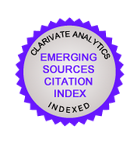Rhizosphere K-mobilizing bacteria Bacillus capability of glyphosate metabolization with methylglycyn formation
https://doi.org/10.29235/1561-8323-2025-69-3-258-264
Abstract
Rhizosphere bacteria Bacillus, preserved in the of the Institute for Soil Science and Agrochemistry, were characterized as promising plant inoculants under intensive application of herbicide glyphosate. Bacteria strains Bacillus K-32, K-54, K-62, K-65, K-81, and Kт were found to metabolize glyphosate without the formation of aminomethylphosphonic acid. Bacteria strains Bacillus K-32, K-54, K-62, K-65, K-81 and Kт are capable of glyphosate decomposition with the formation of safe chemical products. These chemical products include sarcosin (methylglycine) and inorganic phosphate (Pi). The destruction activities of Bacillus strains were calculated on the basis of the accumulation of inorganic phosphate in culture liquids. Under glyphosate concentration of 300 mg/l, the destruction activities of Bacillus K-32, K-54, K-62, K-65, K-81, and Kт strains were equal to: 50.6, 43.9, 48.4, 46.3, 65.4 and 64.4 %, respectively. Under glyphosate content 500 mg/l, the destruction activities were equal to: 40.6, 38.6, 40.1, 42.2, 58.4 and 48.1 % respectively. The application of potassium-mobilizing rhizobacteria Bacillus as inoculants resulted in a significant stimulation effect on plants at high diapason of glyphosate content in the soil (0–50 l/ha). This stimulation effect is manifested in plant growth (stems and roots) and the improvement of plant potassium nutrition.
About the Authors
V. V. LapaBelarus
Lapa Vitaly V. – Academician, D. Sc. (Agrarian), Professor, Chief Researcher
90, Kazinets Str., 220108, Minsk
N. A. Mikhailovskaya
Belarus
Mikhailovskaya Natalia A. – Ph. D. (Agrarian), Associate
Professor, Head of the Laboratory
90, Kazinets Str., 220108, Minsk
T. V. Pahirnitskaya
Belarus
Pahirnitskaya Tatsiana V. – Junior Researcher
90, Kazinets Str., 220108, Minsk
References
1. Zhan H., Feng Y., Fan X., Chen S. Recent advances in glyphosate biodegradation. Applied Microbiology and Biotechnology, 2018, vol. 102, pp. 5033–5043. https://doi.org/10.1007/s00253-018-9035-0
2. Carlisle S. M., Trevors J. T. Glyphosate in the environment. Water, Air and Soil Pollution, 1988, vol. 39, pp. 409–420. https://doi.org/10.1007/bf00279485
3. Chaufan G., Coalova I., Molina M. Glyphosate commercial formulation causes cytotoxicity, oxidative effects, and apoptosis on human cells: Differences with its active ingredient. International Journal of Toxicology, 2014, vol. 33, no. 1, pp. 29–38. https://doi.org/10.1177/1091581813517906
4. Mikhailouskaya N. A. Gliphosate and aminomethylphosphonic acid in the environment and their microbial transformation. Vestsі Natsyyanal’nai akademіі navuk Belarusі. Seryya agrarnykh navuk = Proceedings of the National Academy of Sciences of Belarus. Agrarian series, 2024, vol. 62, no. 2, pp. 114–125 (in Russian). https://doi.org/10.29235/1817-72042024-62-2-114-125
5. Kamat S. S., Raushel F. M. The enzymatic conversion of phosphonates to phosphate by bacteria. Current Opinion in Chemical Biology, 2013, vol. 17, no. 4, pp. 589–596. https://doi.org/10.1016/j.cbpa.2013.06.006
6. Sviridov А. V., Shushkova T. V., Epiktetov D. O., Tarlachkov S. V., Ermakova I. T., Leontievskii A. A. Biodegradation of organophosphorus pollutants by soil bacteria: biochemical aspects and unsolved problems. Biotechnology, 2020, vol. 36, no. 4, pp. 126–135. https://doi.org/10.21519/0234-2758-2020-36-4-126-135
7. Mikhailovskaya N. A. Quantitative estimation of potassium-mobilizing bacteria activity and their efficiency for winter rye cultivation. Vestsі Natsyyanal’nai akademіі navuk Belarusі. Seryya agrarnykh navuk = Proceedings of the National Academy of Sciences of Belarus. Agrarian series, 2006, no. 3, pp. 41–46 (in Russian).
8. Lapa V. V., Mikhailovskaya N. A., Barashenko T. B. The effectiveness of bacterial fertilizer kaliplant on soddy- podzolic sandy loam soil with different sufficiency of moving potassium. Agrokhimiya = Agrochemistry, 2016, no. 6, pp. 29– 38 (in Russian).
9. Mikhailovskaya N. A., Mikanova O., Barashenko T. B., Barashenko T. V. Activity of phosphate mobilization by rhyzobacteria. Pochvovedenie i Agrokhimiya = Soil Science and Agrochemistry, 2007, no. 1 (38), pp. 225–231 (in Russian).
10. Mikhailovskaya N. A., Barashenko T. B. Antagonistic activity of rhyzobacteria A. brasilense and B. circulans in respect of phytopathological micromycets Fusarium and Alternaria. Pochvovedenie i Agrokhimiya = Soil Science and Agrochemistry, 2019, no. 1 (62), pp. 234–244 (in Russian).
11. Mikhailouskaya N., Tchernysh A. K-mobilizing bacteria and their effect on wheat yield. Agronomijas vestis = Latvian Journal of Agronomy, 2005, vol. 8, pp. 147–150.
12. Mikhailouskaya N. A., Barashenko T. B., Pogirnitskaya T. V., Dusova S. V. Screening the capability of potassium mobilizing rhizobacteria to metabolise herbicide glyphosate. Pochvovedenie i Agrokhimiya = Soil Science and Agrochemistry, 2022, no. 1 (68), pp. 200–212 (in Russian). https://doi.org/10.47612/0130-8475-2022-1(68)-200-212
13. Zelenkova N. F., Vinokurova N. G. Determination of glyphosate and its biodegradation products by chromatographic methods. Journal of Analytical Chemistry, 2008, vol. 63, no. 9, pp. 871–874. https://doi.org/10.1134/s106193480809013x
14. Ragab M. T. H. Thin-layer chromatographic detection of glyphosate herbicide (N-phosphonomethyl glycine) and its aminomethyl phosphonic acid metabolite. Chemosphere, 1978, vol. 7, no. 2, pp. 143−153. https://doi.org/10.1016/00456535(78)90041-3
15. Murphy J., Riley J. P. A modified single solution method for the determination of phosphate in natural waters. Analytica Chimica Acta, 1962, vol. 27, pp. 31–36. https://doi.org/10.1016/s0003-2670(00)88444-5













































